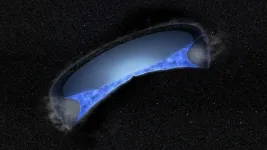(Press-News.org) At a glance:
A small population of airway neurons alerts the brain about a flu infection, according to a new study in mice
The results help explain how drugs like ibuprofen and aspirin reduce flu symptoms
The findings could help scientists develop more-effective flu therapies
A new study led by researchers at Harvard Medical School illuminates how the brain becomes aware that there is an infection in the body.
Studying mice, the team discovered that a small group of neurons in the airway plays a pivotal role in alerting the brain about a flu infection. They also found signs of a second pathway from the lungs to the brain that becomes active later in the infection.
The study was published March 8 in Nature.
Although most people are sick several times a year, scientific knowledge of how the brain evokes the feeling of sickness has lagged behind research on other bodily states such as hunger and thirst. The paper represents a key first step in understanding the brain-body connection during an infection.
“This study helps us begin to understand a basic mechanism of pathogen detection and how that’s related to the nervous system, which until now has been largely mysterious,” said senior author Stephen Liberles, professor of cell biology in the Blavatnik Institute at HMS and an investigator at Howard Hughes Medical Institute.
The findings also shed light on how nonsteroidal anti-inflammatory drugs such as ibuprofen and aspirin alleviate influenza symptoms.
If the results can be translated into humans, the work could have important implications for developing more-effective flu therapies.
An infectious state of mind
The Liberles lab is interested in how the brain and body communicate to control physiology. For example, it has previously explored how the brain processes sensory information from internal organs, and how sensory cues can evoke or suppress the sensation of nausea.
In the new paper, the researchers turned their attention to another important type of sickness that the brain controls: sickness from a respiratory infection.
During an infection, Liberles explained, the brain orchestrates symptoms as the body mounts an immune response. These can include broad symptoms such as fever, decreased appetite, and lethargy, as well as specific symptoms such as congestion or coughing for a respiratory illness or vomiting or diarrhea for a gastrointestinal bug.
The team decided to focus on influenza, a respiratory virus that is the source of millions of illnesses and medical visits and causes thousands of deaths in the United States every year.
Through a series of experiments in mice, first author Na-Ryum Bin, HMS research fellow in the Liberles lab, identified a small population of neurons embedded in the glossopharyngeal nerve, which runs from the throat to the brain.
Importantly, he found that these neurons are necessary to signal to the brain that a flu infection is present and have receptors for lipids called prostaglandins. These lipids are made by both mice and humans during an infection, and they are targeted by drugs such as ibuprofen and aspirin.
Cutting the glossopharyngeal nerve, eliminating the neurons, blocking the prostaglandin receptors in those neurons, or treating the mice with ibuprofen similarly reduced influenza symptoms and increased survival.
Together, the findings suggest that these airway neurons detect the prostaglandins made during a flu infection and become a communication conduit from the upper part of the throat to the brain.
“We think that these neurons relay the information that there’s a pathogen there and initiate neural circuits that control the sickness response,” Liberles said.
The results provide an explanation for how drugs like ibuprofen and aspirin work to reduce flu symptoms — and suggest that these drugs may even boost survival.
The researchers discovered evidence of another potential sickness pathway, this one traveling from the lungs to the brain. They found that it appears to become active in the second phase of infection as the virus infiltrates deeper into the respiratory system.
This additional pathway doesn’t involve prostaglandins, the team was surprised to find. Mice in the second phase of infection didn’t respond to ibuprofen.
The findings suggest an opportunity for improving flu treatment if scientists are able to develop drugs that target the additional pathway, the authors said.
A foundation for future research
The study raises a number of questions that Liberles and colleagues are eager to investigate.
One is how well the findings will translate to humans. Although mice and humans share a lot of basic sensory biology, including having a glossopharyngeal nerve, Liberles emphasized that researchers need to conduct further genetic and other experiments to confirm that humans have the same neuron populations and pathways seen in the mouse study.
If the findings can be replicated in humans, it raises the possibility of developing treatments that address both the prostaglandin- and nonprostaglandin pathways of flu infection.
“If you can find a way to inhibit both pathways and use them in synergy, that would be incredibly exciting and potentially transformative,” Liberles said.
Bin is already delving into the details of the nonprostaglandin pathway, including the neurons involved, with the goal of figuring out how to block it. He also wants to identify the airway cells that produce prostaglandins in the initial pathway and study them in more depth.
Liberles is excited to explore the full diversity of sickness pathways in the body to learn whether they specialize for different types and sites of infection. Deeper understanding of these pathways, he said, can help scientists learn how to manipulate them to better treat a range of illnesses.
Authorship, funding, disclosures
Additional authors on the study include Sara Prescott, Nao Horio, Yandan Wang of HHMI and HMS, and Isaac Chiu of HMS.
The research was supported by the National Institutes of Health (DP1 AT009497; R01 HL132255), the Chan Zuckerberg Initiative, a Banting Postdoctoral Fellowship, and a Harvard Medical School Goldberg Fellowship.
Liberles is a consultant for Kallyope.
END
How the Brain Senses Infection
Researchers discovered specific airway neurons in mice that alert the brain about the flu
2023-03-08
ELSE PRESS RELEASES FROM THIS DATE:
ALMA traces history of water in planet formation back to the interstellar medium
2023-03-08
Scientists studying a nearby protostar have detected the presence of water in its circumstellar disk. The new observations made with the Atacama Large Millimeter/submillimeter Array (ALMA) mark the first detection of water being inherited into a protoplanetary disk without significant changes to its composition. These results further suggest that the water in our Solar System formed billions of years before the Sun. The new observations are published today in Nature.
V883 Orionis is a protostar located roughly 1,305 light-years from Earth in the constellation Orion. ...
Study shows racial inequities in newborn drug testing
2023-03-08
ANN ARBOR, Mich. – If a newborn tests positive for certain drugs after birth, mandated reporters in many states – including health care professionals and social workers – are required to report it to Child Protective Services.
But guidelines on what should trigger these tests are often unclear and inconsistent, which studies have shown may contribute to racial inequities in who gets tested.
Residents, faculty, medical students and researchers at Michigan Medicine’s Department of Family Medicine and Antiracism and Health Equity Program wanted to determine rates of newborn drug testing and if these rates varied by ...
During COVID, Black children were 100x more likely than White children to experience gun injuries
2023-03-08
EMBARGOED UNTIL 11:00 AM EST Wednesday, March 8, 2023
Contact:
Jillian McKoy, jpmckoy@bu.edu
Michael Saunders, msaunder@bu.edu
##
Gun violence—and racial disparities in gun violence—have increased substantially during the pandemic, particularly among children. Now a new study led by a Boston University School of Public Health (BUSPH) researcher shows just how stark these differences in risk of firearm injury are between White and non-White children.
Published as a research letter in JAMA Network Open, the study examined gun injuries among children in four major US cities—New York City, Chicago, Los Angeles, and Philadelphia—and ...
Eyes in the sky: using drones to assess the severity of crop diseases
2023-03-08
Rice is one of the most important crops in the world and constitutes the primary food source for over half of Earth’s population. Protecting rice plantations from disease is therefore an essential endeavor in modern agriculture. Of the many pathogens that can infect rice plants, the bacterium Xanthomonas oryzae, which is responsible for bacterial blight (BB), is among the worst. Hundreds of millions of dollars’ worth of crops are lost each year due to BB, and millions of dollars are spent in preventive measures and research.
One of the most fruitful strategies to control BB and other crop diseases is to grow genetically resistant cultivars. However, as pathogens can ...
New Insights by Mass General on the molecular mechanism of hydrocephalus could lead to the first-ever non-surgical treatment
2023-03-08
BOSTON – Mass General researchers have discovered a novel molecular mechanism responsible for the most common forms of acquired hydrocephalus, potentially opening the door to the first-ever nonsurgical treatment for a life-threatening disease that affects about a million Americans. As reported in the journal Cell, the team uncovered in animal models the pathway through which infection or bleeding in the brain triggers a massive neuroinflammatory response that results in increased production of cerebrospinal fluid (CSF) ...
Analyzing child firearm assault injuries by race, ethnicity during pandemic
2023-03-08
About The Study: Child firearm assaults increased substantially during the COVID-19 pandemic in four major U.S. cities, according to the results of this study. Racial and ethnic disparities increased, as Hispanic, Asian, and especially Black children experienced disproportionate shares of the increased violence.
Authors: Jonathan Jay, Dr.P.H., J.D., of the Boston University School of Public Health in Boston, is the corresponding author.
To access the embargoed study: Visit our For The Media website at this link https://media.jamanetwork.com/
(doi:10.1001/jamanetworkopen.2023.3125)
Editor’s ...
eDNA holds the key to safeguarding pollinators amid global declines: Study
2023-03-08
Curtin researchers have uncovered new evidence of western pygmy possums interacting with native flowers, providing the first eDNA study to simultaneously detect mammal, insect and bird DNA on flowers.
The new research, published today in Environmental DNA, examined DNA traces left by animal pollinators on native flora and detected both insect and animal pollinators from multiple flowering plant species at once - a game changer in the face of declining animal pollinators globally.
In North America, some pollinator species have fallen by more than 95 per cent while ...
SIAM Conference on Computational Geometric Design (GD23)
2023-03-08
The 2023 SIAM Conference on Computational Geometric Design, organized by the SIAM Activity Group on Geometric Design, is part of the International Geometry Summit bringing together the Symposium on Physical and Solid Modeling 2023, Shape Modeling International 2023, EG Symposium on Geometry Processing 2023, and Geometric Modeling and Processing 2023.
The 2023 SIAM Conference on Computational Geometric Design seeks high quality, original research contributions that strive to advance all aspects ...
Study associates long COVID with physical inactivity
2023-03-08
The link between symptoms of COVID-19 and physical inactivity is increasingly evident. An article recently published in the journal Scientific Reports by researchers at the University of São Paulo (USP) in Brazil describes a study in which COVID-19 survivors with at least one persistent symptom of the disease were 57% more likely to be sedentary, and the presence of five or more post-acute sequelae of infection by SARS-CoV-2 increased the odds of physical inactivity by 138%.
“Although this was a cross-sectional study, the findings underscore the importance of discussing and encouraging physical activity at all times, including during the pandemic,” ...
Scientists uncover the unexpected identity of mezcal worms
2023-03-08
Mezcal is a distilled alcohol made from the boiled and fermented sap of agave plants. Most mezcal beverages — including all brands of tequila — are sold as pure distillates, but a few have an added stowaway bottled inside: worms.
Called gusanos de maguey (Spanish for agave worms), these odd organic chasers aren’t actually worms, but instead a type of insect larva, and their addition to mezcal is a recent one. Mezcal production has a storied history, dating back to the first Spanish inhabitants of Mexico, but larvae were only added to the drink in ...
LAST 30 PRESS RELEASES:
Numbers in our sights affect how we perceive space
SIMJ announces global collaborative book project in commemoration of its 75th anniversary
Air pollution exposure and birth weight
Obstructive sleep apnea risk and mental health conditions among older adults
How talking slows eye movements behind the wheel
The Ceramic Society of Japan’s Oxoate Ceramics Research Association launches new international book project
Heart-brain connection: international study reveals the role of the vagus nerve in keeping the heart young
Researchers identify Rb1 as a predictive biomarker for a new therapeutic strategy in some breast cancers
Survey reveals ethical gaps slowing AI adoption in pediatric surgery
Stimulant ADHD medications work differently than thought
AI overestimates how smart people are, according to HSE economists
HSE researchers create genome-wide map of quadruplexes
Scientists boost cell "powerhouses" to burn more calories
Automatic label checking: The missing step in making reliable medical AI
Low daily alcohol intake linked to 50% heightened mouth cancer risk in India
American Meteorological Society announces Rick Spinrad as 2026 President-Elect
Biomass-based carbon capture spotlighted in newly released global climate webinar recording
Illuminating invisible nano pollutants: advanced bioimaging tracks the full journey of emerging nanoscale contaminants in living systems
How does age affect recovery from spinal cord injury?
Novel AI tool offers prognosis for patients with head and neck cancer
Fathers’ microplastic exposure tied to their children’s metabolic problems
Research validates laboratory model for studying high-grade serous ovarian cancer
SIR 2026 delivers transformative breakthroughs in minimally invasive medicine to improve patient care
Stem Cell Reports most downloaded papers of 2025 highlight the breadth and impact of stem cell research
Oxford-led study estimates NHS spends around 3% of its primary and secondary care budget on the health impacts of heat and cold in England
A researcher’s long quest leads to a smart composite breakthrough
Urban wild bees act as “microbial sensors” of city health.
New study finds where you live affects recovery after a hip fracture
Forecasting the impact of fully automated vehicle adoption on US road traffic injuries
Alcohol-related hospitalizations from 2016 to 2022
[Press-News.org] How the Brain Senses InfectionResearchers discovered specific airway neurons in mice that alert the brain about the flu



